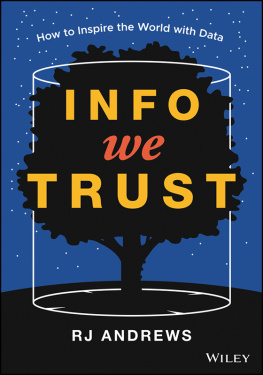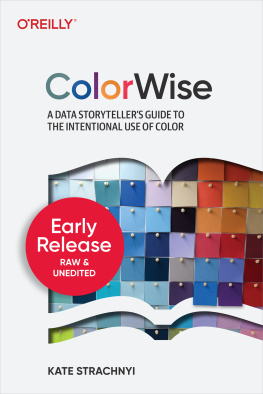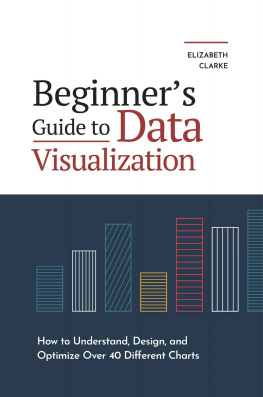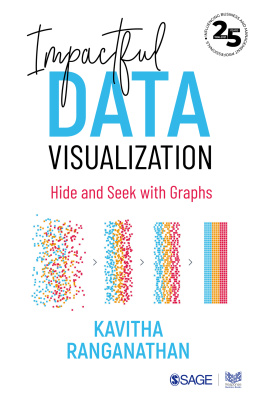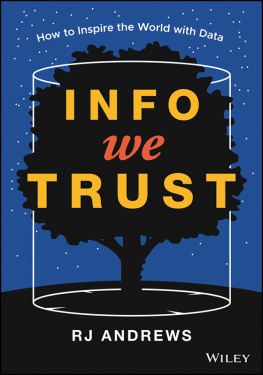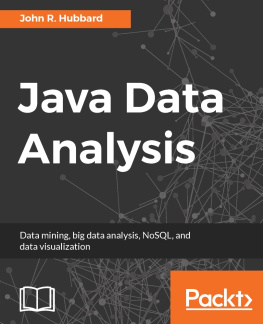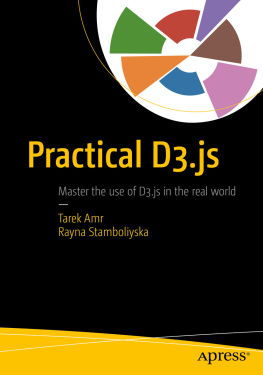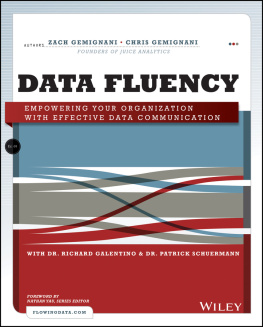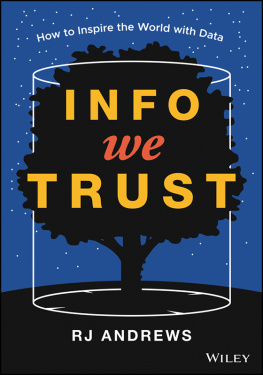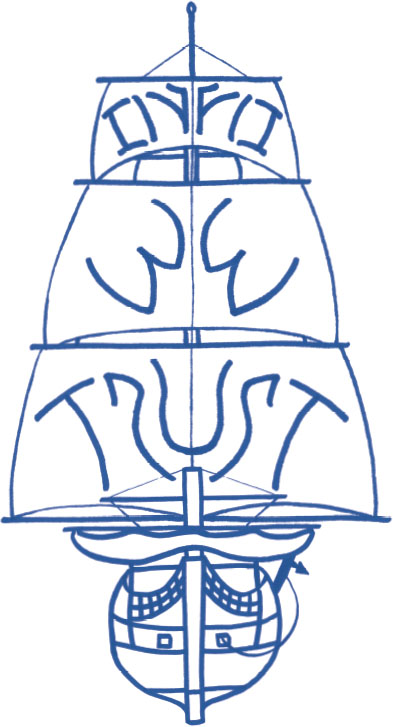written and illustrated by
RJ ANDREWS
Cover design: Wiley and RJ Andrews
Copyright 2019 by John Wiley & Sons, Inc. All rights reserved.
Published by John Wiley & Sons, Inc., Hoboken, New Jersey.
Published simultaneously in Canada.
A trademark application for Info We Trust' has been submitted for review to the U.S. Patent and Trademark Office.
No part of this publication may be reproduced, stored in a retrieval system, or transmitted in any form or by any means, electronic, mechanical, photocopying, recording, scanning, or otherwise, except as permitted under Section 107 or 108 of the 1976 United States Copyright Act, without either the prior written permission of the Publisher, or authorization through payment of the appropriate per-copy fee to the Copyright Clearance Center, Inc., 222 Rosewood Drive, Danvers, MA 01923, (978) 750-8400, fax (978) 646-8600, or on the Web at www.copyright.com. Requests to the Publisher for permission should be addressed to the Permissions Department, John Wiley & Sons, Inc., 111 River Street, Hoboken, NJ 07030, (201) 748-6011, fax (201) 748-6008, or online at www.wiley.com/go/permissions.
Limit of Liability/Disclaimer of Warranty: While the publisher and author have used their best efforts in preparing this book, they make no representations or warranties with respect to the accuracy or completeness of the contents of this book and specifically disclaim any implied warranties of merchantability or fitness for a particular purpose. No warranty may be created or extended by sales representatives or written sales materials. The advice and strategies contained herein may not be suitable for your situation. You should consult with a professional where appropriate. Neither the publisher nor author shall be liable for any loss of profit or any other commercial damages, including but not limited to special, incidental, consequential, or other damages.
For general information on our other products and services or for technical support, please contact our Customer Care Department within the United States at (800) 762-2974, outside the United States at (317) 572-3993, or fax (317) 572-4002.
Wiley publishes in a variety of print and electronic formats and by print-on-demand. Some material included with standard print versions of this book may not be included in e-books or in print-on-demand. If this book refers to media such as a CD or DVD that is not included in the version you purchased, you may download this material at http://booksupport.wiley.com. For more information about Wiley products, visit www.wiley.com.
Names: Andrews, RJ, (Digital storyteller), author.
Title: Info we trust : how to inspire the world with data / written and illustrated by RJ Andrews.
Description: Hoboken, New Jersey : John Wiley & Sons, 2019. | Includes bibliographical references and index. |
Identifiers:LCCN2018048217(print)| LCCN2018056994(ebook)
| ISBN978-1-119-48390-8(ePub)| ISBN978-1-119-48389-2(hardcover)| ISBN978-1-119-48391-5(ePDF)
Subjects: LCSH: Information visualization. | Digital storytelling.
Classification: LCCQA76.9.I52 (ebook) | LCCQA76.9.I52 .A54 2019 (print) |
DDC001.4/226dc23
LCrecord available at https://lccn.loc.gov/2018048217
For Kelly,
my North Star
Of course the first thing to do was to make a grand survey of the country she was going to travel through. It's something very like learning geography,' thought Alice, as she stood on tiptoe in hopes of being able to see a little further.
LEWIS CARROLL
THROUGH THE LOOKING-GLASS, AND WHAT ALICE FOUND THERE

PREFACE
ANCIENT ROOTS
Dreu is an ancient word that means tree. It is sometimes written as dru or deru. It is a word so old that we can no longer read it directly. We intuit its prehistoric existence by the long shadow it casts across language. Many more recent words share a similar sound and similar meaning. The Sanskrit word dru (tree or wood) is one example of an old descendant of dreu. Today, dreu's shadow persists in words like druid (tree seer) and dryad (wood nymph).
Over time, dreu evolved to embody the functional qualities of wood: solid, firm, strong. These qualities traveled with its sound into Europe, where it became the Ancient Greek dron (strong, mighty), Latin durus (hard, rough), and the Old Norse trausta (strong). The corresponding Old Norse traust conveyed a type of social strength: help, confidence, protection and assistant support. This social bond evolved into the Old High German word trost (fidelity), from which we can most clearly identify the modern word trust.
Trust is a firm belief in the strength or reliability of something or someone. It is a precious thing, not easily gained, and often in short supply. Trust conveys a confidence in the signals the world is delivering to you: They must be true, or at least in some sort of harmony with facts and reality. Trust is forever tied linguistically to truth, from the Old English treowian (to believe) and treowe (faithful). Both also stem from the ancient word dreu. They are almost indistinguishable from treow, the Old English word for tree.
The word information also has a social origin story. Today, information is defined as facts provided or learned. Information is what is represented and conveyed by a particular arrangement. The spirit of information lies in its transmission. The word stems from the Latin verb informare: to shape or fashion. Its roots combine for a dynamic picture: in (into), forma (a form), and ation (something resulting of an action). Information is putting things into a particular form. Information is action.
In an epic way, information and trust, knowledge and trees, have been associated for a long time. Trees provide us with shelter, protection, food, medicine, fire, energy, weapons, tools, and construction materials. Stretching against gravity, from beneath the earth to the heavens above, trees are powerful symbols of growth, decay, and resurrection. Across history, trees were revered around the world. Ancient Assyrians, Akkadians, and Egyptians all had sacred trees. Gautama Buddha's scene of enlightenment occurs under the holy Bodhi tree. Isaac Newton watched an apple fall in his mother's garden, and the secrets of gravity began to unfold. The Mayan tree of life provided an axis onto which the universe clings. The Norse Yggdrasil tree provides a similar skeleton that connects the underworld, middle earth, and heavens.
These revered trees are all expressions of the axis mundi, the cosmic world axis. It appears throughout world beliefs and philosophies as the pole at the center of the world. The axis mundi is visually suggested in nature by a tree, mountain, vine, column of smoke, stalk of grain, and sometimes the upright human form itself. The axis mundi is reflected in human design too. Picture a tower, ladder, flagpole, cross, steeple, minaret, totem pole, pillar, obelisk, rocket, or skyscraper. The axis mundi symbol may originate with our own evolutionary ancestors, who lived in trees. Back then, the tree was at the center of their world. Its trunk was the axis connecting the dangers of the forest floor to the energy of the sun.

